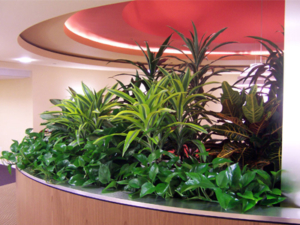Interiorscape Basics
Introduction
Welcome to the fascinating world of interiorscaping!
In nature, there is no such thing as an indoor plant. To help clean our indoor air, to soften architectural spaces and to give us something to anchor us to our natural world, we have brought plants indoors and made them an important part of our daily lives. To care for indoor plants is to do something almost magical: keep plants alive and thriving indoors.

Indoor plants create beauty in your space
When we set out to create this book, our goal was to help you do your job better and expand your knowledge of interiorscape plant care, thereby keeping our urban world green and growing. Armed with new knowledge of plants and your nurturing ways, you will be able to defy the rules and create lovely plants that can live and grow in unnatural indoor surroundings. Let’s start with a review of how to properly care for indoor plants and make them flourish by examining the Ten Golden Rules of Interiorscaping.
Ten Golden Rules of Interiorscaping
- Don’t drown them. Roots need air as well as water. Keeping the soil soaked at all times means certain death for most plants. When learning how much water each plant needs, take into consideration not only the type of plant but also the amount of light it gets, the season of the year, how long the plant has been in its location and the average temperature of its immediate environment.
- Keep them clean. A clean plant is a healthy plant; keep the leaves dust and dirt free. Washing leaves periodically with soap and water helps the plant “breathe” and controls insect infestations, as well. Prune off dead leaves and branches. Soil and moss should be free of trash and debris. A clean plant makes a happy customer.
- Help them look their best. Now that the plant is clean, make sure it is standing up straight, make sure the moss completely covers the grow pots and make sure the decorative container is clean. Turn the plant so its best side is facing the client.
- Choose wisely. The plant you choose must be able to survive in its future environment. Place a sun-loving plant near a window. Use low light plants in darker areas. If a plant is placed incorrectly, speak with your supervisor about the possibility of switching its location or changing plant types to keep all plants in your account looking good at all times.
- Give them a rest. Nearly all interiorscape plants grow slower in winter. This means less water, no fertilizer and less leaf production than in their active growing period. Most plants used by interiorscapers give little to no sign as to when their natural period of rest is beginning until signs of stress appear. Even though there may be fewer daylight hours in winter, the office lights are on longer because of it. In addition, it’s cooler outside so the heat is set to kick on, making the environment warmer and lowering the humidity! With these changing conditions always stop and re-check your work to make sure you are giving the correct amount of water. Caring for interior plants can be tricky at this time of year.
- Accept the loss of temporary plants. Some plants, such as Cyclamen, Chrysanthemum, Kalanchoe and other seasonal flowers will be through blooming in a matter of weeks. They are temporary residents in your interiorscape care and that is all. Help your clients realize it’s time to move on to new plants when the blooms fade.
- Rarely repot. Most plants in the interiorscape environment rarely, if ever, need repotting. That being said, the addition of fresh soil to the existing grow pot once per year will help keep things healthy and green. Even if your customer is sure it needs repotting, inspect the root zone for crowding before you increase the grow pot size.
- Learn customer service skills. You are not only providing service to the plants in your care, but you are also supplying the people who are your clients with a service. Be kind to plants and people.
- Be prepared. Make sure you have everything needed to service your accounts before you leave for the day. At a minimum, have with you at all times soap, a moisture meter or probe, scissors and a watering bucket with a sponge. In addition, your vehicle should contain the extra items you may need throughout the day to provide excellent service.
- Treat trouble promptly. Whether you are an expert or just starting out, trouble will strike. One or two scale insects or mealybugs are easily picked off; but a large infestation may be incurable. Overwatering is not fatal at first but kills a containerized plant over a prolonged period of time. One slow replacement plant may not make a client decide to look for a new service, but if she has to ask more than once it may spell trouble. Learn how to recognize early signs of trouble and deal with them as soon as you notice.
